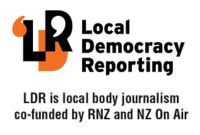Toilet talks stall: Cemetery loos divide Ashburton council

The decision on where to put new public toilets in the Ashburton Cemetery is on hold after a hung vote.
Councillors were voting on placing a new toilet block in the centre of the cemetery – between the old Bremner Lawn and newer Seafield Lawn – and demolishing the old toilets.
The existing 1960's block uses a septic tank and is nearing its end of life.
The council had three options: Option one was for a new facility on both sides of the cemetery at a cost of $598,944.
Option two was for a new block on the new Seafield Lawn for $288,345 and leave the old block until it reaches the end of its life, which costs $15,000 to remove.
Option three, which councillors voted on and remains the active motion, is for the new loos to be built in the centre of the cemetery for $288,345 and demolishing the old block for $15,000.
Prior to the vote, Mayor Brown had suggested no toilet at all.
“I can’t see the need.
“I also question the actual usage and whether we should be spending money on toilet there.
“No other cemeteries in the district have toilets.”
Councillor Carolyn Cameron, who supported building a new toilet, suggested there was “an information shortage”.
She wanted to know the usage of the existing toilets and more detail on the funding impacts of the options.
“It would be nice to have the confidence that there is the demand for new facilities before we build new facilities.”
Councillors voted 5-5 on option three, but rather than Mayor Neil Brown using his casting vote, chief executive Hamish Riach suggested the decision wait due to the number of unanswered questions.
Riach said usage data would only be anecdotal as the old facility does not have counters or cameras so this would require a period of time to gather, but the funding information would be presented at the April 19 council meeting.
Councillors agreed to leave the motion on the table until the additional answers are provide at the next meeting.
By Jonathan Leask

